 |
Nursery Workshop |
| Home Recommend This Site To A Friend |
|
SRGC Nursery Workshop 2 by Ian Christie April 2004. Cultural information and hints on growing Hepatica (Latin definition - Noble Liverwort) A member of the Buttercup family and although not a native of Britain the Hepatica grows well especially in deciduous woodland even coniferous forests or shady situations. In the wild some species live on limestone while others grow in acid situations but all enjoy the good top dressing of leaf mould which nature provides in Autumn. In winter when the trees are bare the roots provide good drainage, moisture of winter promotes new growth, and flowering occurs during early March, the new leaves then emerge just as the canopy provided by the trees keep the plants cool during the Spring and Summer. Hepaticas form small clumps and are usually semi-evergreen perennials. After flowering the hairy new foliage unfurls to produce glossy green or marbled three (or up to 5) lobed leaves. Although primarily a woodland plant we have found with good drainage they will thrive in a cool crevice or corner in the garden and alternatively are well suited to pot culture. Here we mention some of the main species: Hepatica acutliloba an American species which resembles H. nobilis but is identified by its sharply pointed green or occasionally slightly marbled leaves. Flowers are upward facing and often white but can come in pale shades of pink, mauve or blue. Hepatica americana is obviously another American species this one enjoys acid conditions, the flowers are usually a pale mauve, leaves are more rounded and can be heavily marbled. Hepatica nobilis by far the most widely distributed species living throughout Europe, Asia, Russia and America. A neat plant with glossy green or sometimes beautifully marbled leaves, flower colour can range from deep red, bright pink, dark blue, white and numerous shades in between with the occasional double thrown in, flower usually have 7 petals but this can vary. Hepatica transsilvanica is much more limited in its distribution growing in small colonies in Romania especially in the Carpathian Mountains and Transsilvania This plant is a handsome species and is larger in all its parts, flowers come in beautiful shades of blue although there are rarities in pink and white. Hepatica x media this is a cross that occurs between H. nobilis and H. transsilvanica and is again limited in nature to small pockets in Romania. Hepatica japonica the Japanese species comes in many hues and forms as well as some excellent deliberate cultivars, generally the flowers have between 9 and 12 petals most are small but very intense colours, several very fine doubles are available we would love more of these but at the moment the cost is prohibitive. Our hepatica's in pots have been inside a cold glasshouse all winter and are now showing active growth ( Hepaticas early) the first task at this time is to very carefully remove the old leaves this is done one at a time, if you try to remove several you could accidentally damage the dormant flower buds. You will notice from the pictures that most plants are in long pots, for me this seems to be the best way to grow good plants.(Hepatica nobilis) Firstly and perhaps most important is compost, I find that Hepatica's do not like a pure peat based compost as this holds to much water and heats up during summer thus killing plants, here are a few mixes to try: Mix 1 one part John Innes sterilised soil one part Multi purpose compost the ordinary garden centre kind and one part pea gravel. Mix 2 (my mix) Two parts John Innes no3., two parts Pea Gravel and one part Cambark or similar composted bark (If you have access to good leaf mould then use this rather than bark). I have also used Perlite and Vermiculite instead of gravel but gravel is cheap and easy to find here. Potting methods, if you have your own small seedlings or buy a plant from a nursery and you want to either pot up or plant out, remove from small pot, place the plant inside new pot (having put some compost in first) fill the pot to within 5 cm of top and firm around root ball, to provide good drainage top dress around the noses with pea gravel. Make sure you do NOT bury the growing noses/crowns we find if we do this plants will rot because of the wet here. For more mature plants we remove from the pots and cut the lower half of root system away this sounds drastic but on re-potting into same pot with some fresh compost plants grow away very well. Hepatica seedlings 1 Where to find plants seed etc. SRGC seed exchange. SRGC shows, several nurseries at shows do have plants so come along in Spring to a show. Plants from several specialist nurseries, some may import plants from Japan ( at great expense) also some grow their own but as colours are very variable it is best to visit in Spring to select. Bowl with flowers (H nobilis) Hepatica seed is best sown green ie; fresh from the plants, seed may or may not germinate the first year but do NOT give up leave seed pots outside over winter and hopefully the next Spring your patience will be rewarded. (Hepatica seedlings germinated last year) Once seedlings germinate (we) do not disturb them for a whole year, but a weak liquid feed is given once week, young seedlings are usually kept under cover over the winter. When weather permits sometime in late January or early February we pot up the seedlings which will then be actively growing and displaying tight flower buds, again these will be kept under cover of frame until early March when flowering occurs. Several interesting hepatica's have become available for sale over the last few years the best thing about these is that they have wonderful marbled leaves, one such is H. nobilis var Pyrenaica Apple Blossom which has large blush pink flowers with outstanding leaf markings, ( seed for these was collected in the Spanish Pyrenees.) I managed to get a few plants some years ago and have raised many from seed since and now have a range of colours each with good leaves so will have to re-name them Hepatica pyrenaica group, it may take some time to build up numbers but this is definitely worth looking for. Another similar new introduction is H. nobilis Cremar which has large pink flowers and very unusual scalloped leaves with good markings. Many new colour variants are now for sale and look out especially for those with coloured stamens which contrast with the flowers ( hepaticas pictures.) Hepatica's in the Garden Hepaticas in the open garden are best planted under the spreading branches of a Rhododendron or deciduous tree , a quiet shady spot in a raised bed or rock garden, use the same compost as for pots. planting methods as with pots and do not bury growing noses.( Hep. pink garden). All hepatica's once established can be divided including the wonderful doubles that are offered should you be tempted to part with some of your bank balance and purchase these rare plants. I find it best to split Hepaticas very early when I re-pot in spring or late Sep. when plants start to go dormant but our good friend John Massey from Ashwood nursery seems to be able to split plants at anytime. ( John's superb presentation at the SRGC weekend when it was at AYR was awe inspiring.) Hepatica's in containers. I know Ian Young in Aberdeen has a trough planted up with a mixture of very fine plants which is located at the back of his house in a shaded area so if Ian Young can get hepatica's to survive in Aberdeen ( see his Picture on the forum) we can all find somewhere to plant a few. I have several plastic troughs and pots which I have moved around the garden for displays etc all seem quite happy and are tidied up in early spring with a little liquid every month when growing. (Hepatica trough). Other hepaticas. Hepatica transsylvanica these form large mats in the garden and seem to be less fussy than the H. nobilis described above, the do look very similar but the flower colour is not so variable. Hepatica X medeae 'Ballardii' several nurseries list this plant but it is difficult to find the true large blue form. H. transsylvanica Blue Jewel a good large dark blue. De Buis again large pale blue flowers, H. Lodden Blue, Pale blue and H. Lilacina a really nice pink flower. (H. Trans. Pink) These named forms a available form several nurseries with the following more difficult to find and some are expensive so please ask before you buy. H. transsylvanica white, Harvington hybrid, very large blue flowers, Ada Scott a good old clone. Mrs Ellison Spence, a semi double lue.( expensive) Sandy ( named after the late Alex Duguid.) and several good un-named pink forms. I grow all the above outside with no problems except the white form which is not a very strong growing plant and this is kept under cover all winter then out for the growing season. I do think it is important to give some feeding to the plants about once a fortnight , flowers and leaves can get eaten by slugs so a good tidy up, remove old leaves etc will help. H. transsylvanica flwrs . I have not mentioned any of the hepatica's which come from America or Korea nor the odd few others which are within the genus but I can only write about those which I know reasonably well. Good luck with your garden. For more information on any of these pictures, please post your questions in the forum 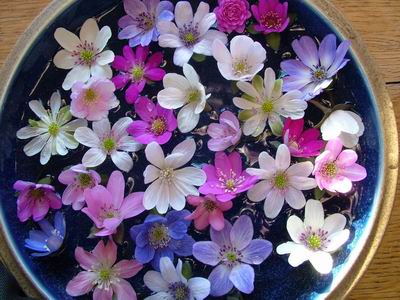
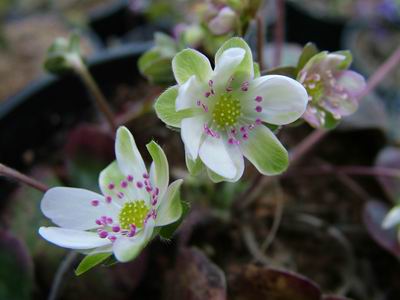
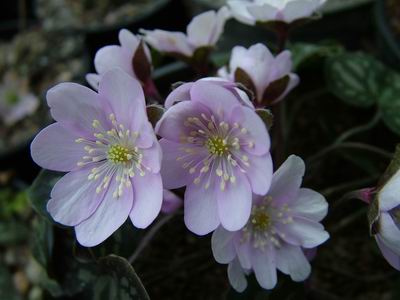

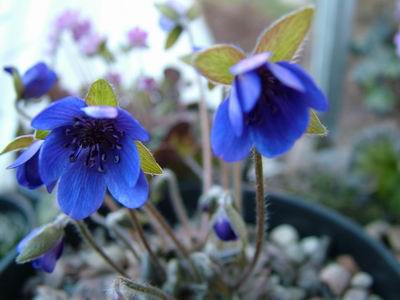
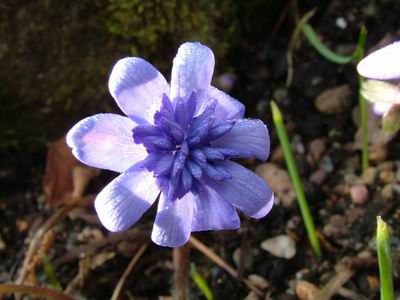
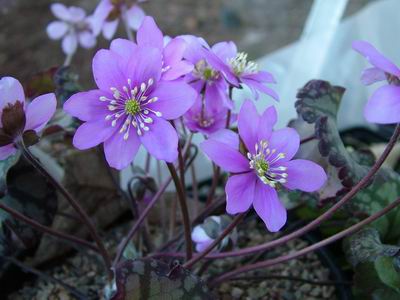
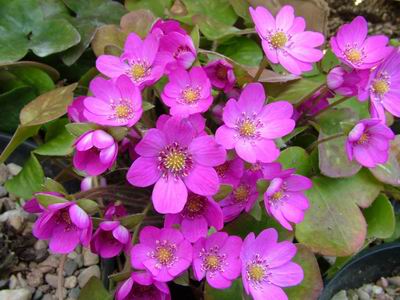
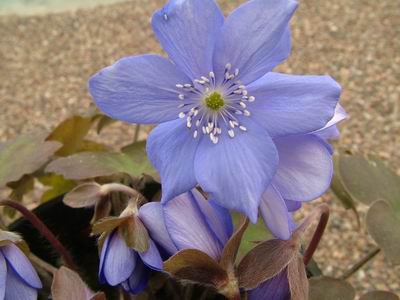
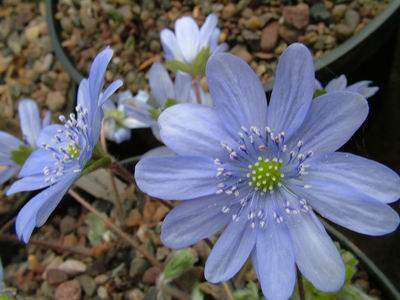
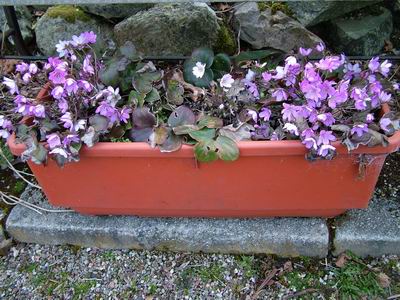
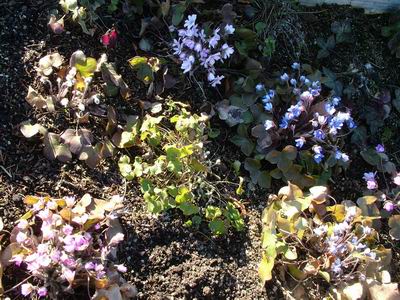
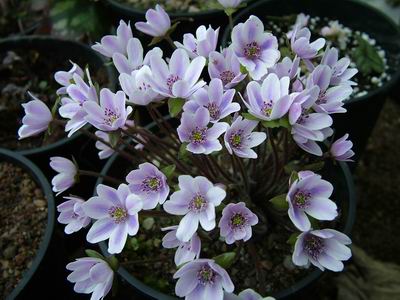
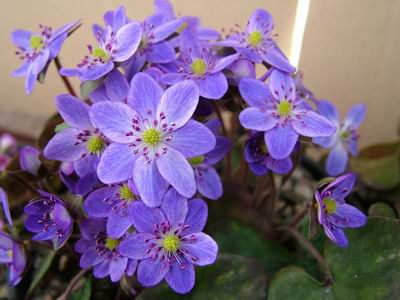
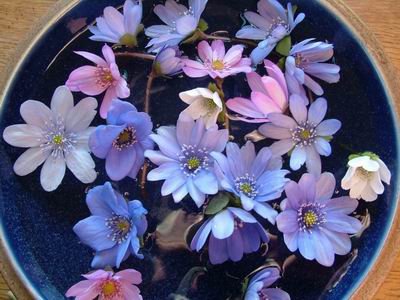

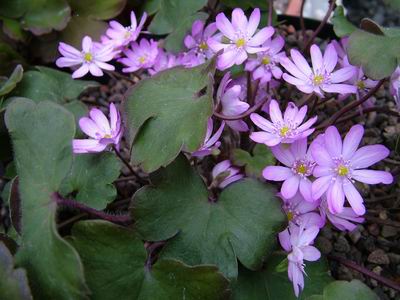
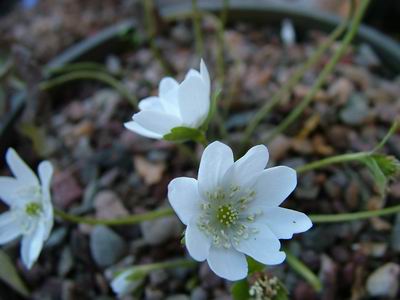
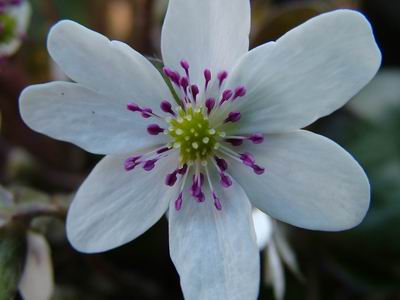
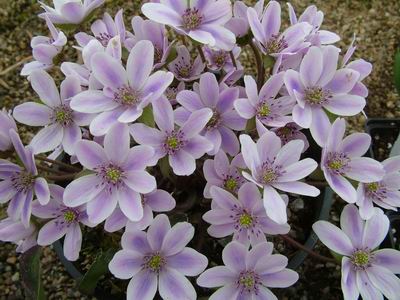
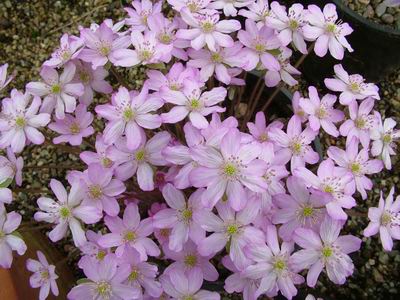
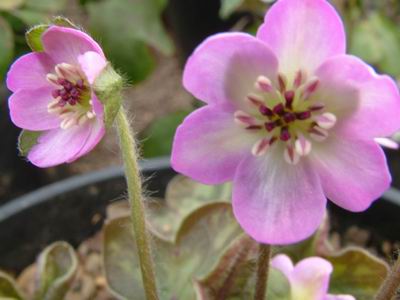
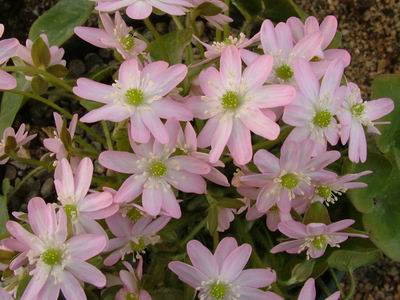
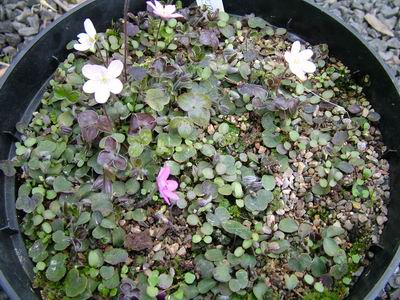

For more information on any of these pictures, please post your questions in the forum ^ back to the top ^ |